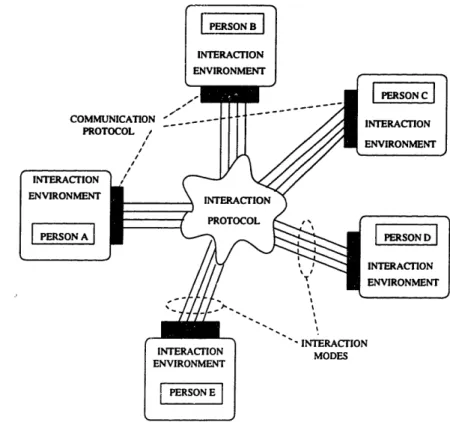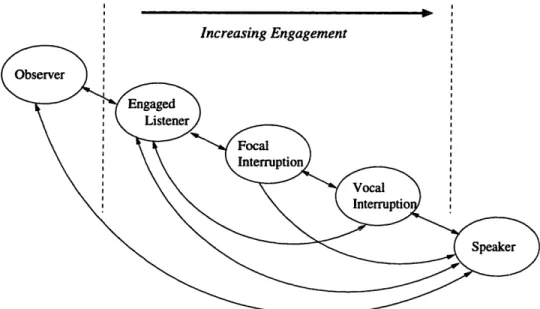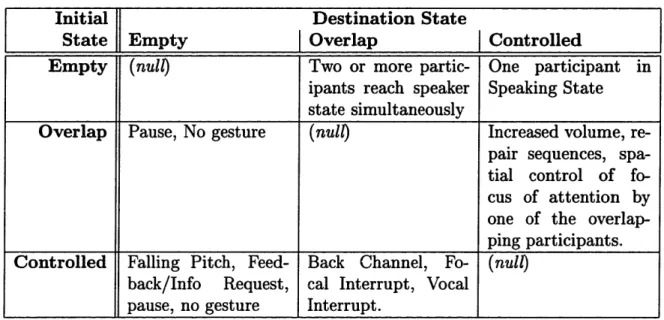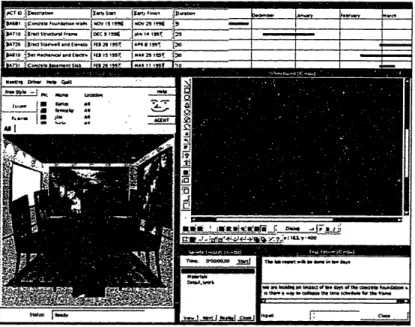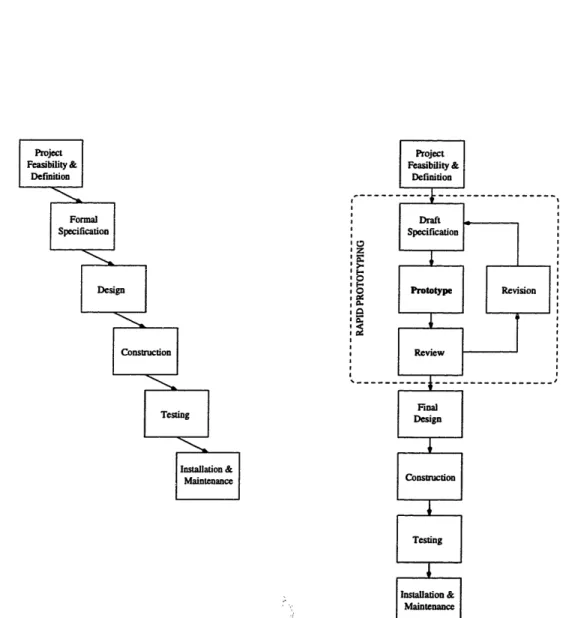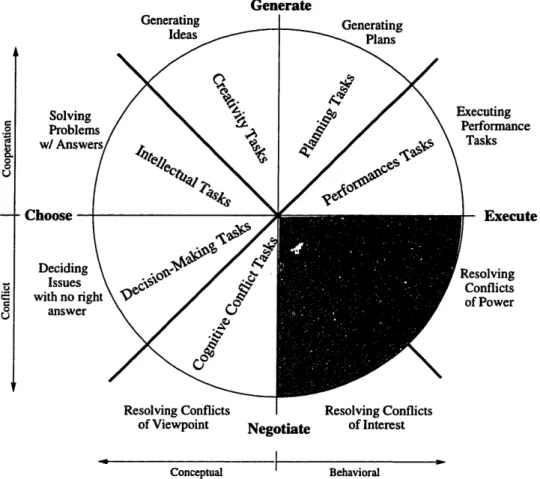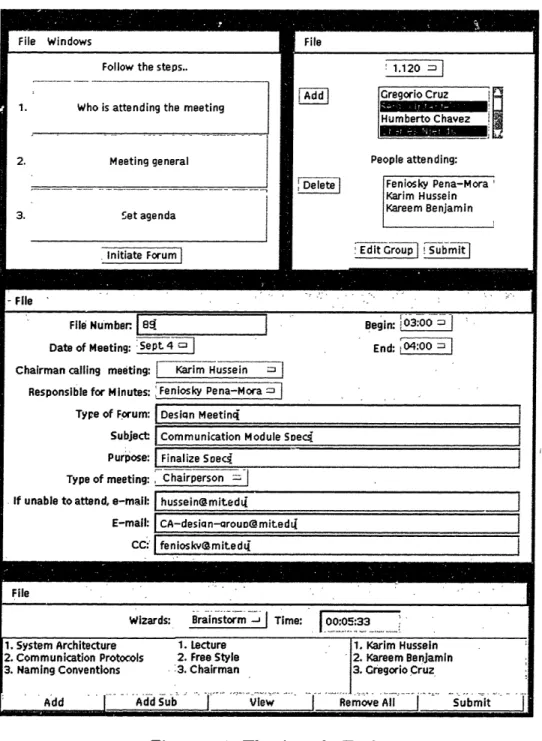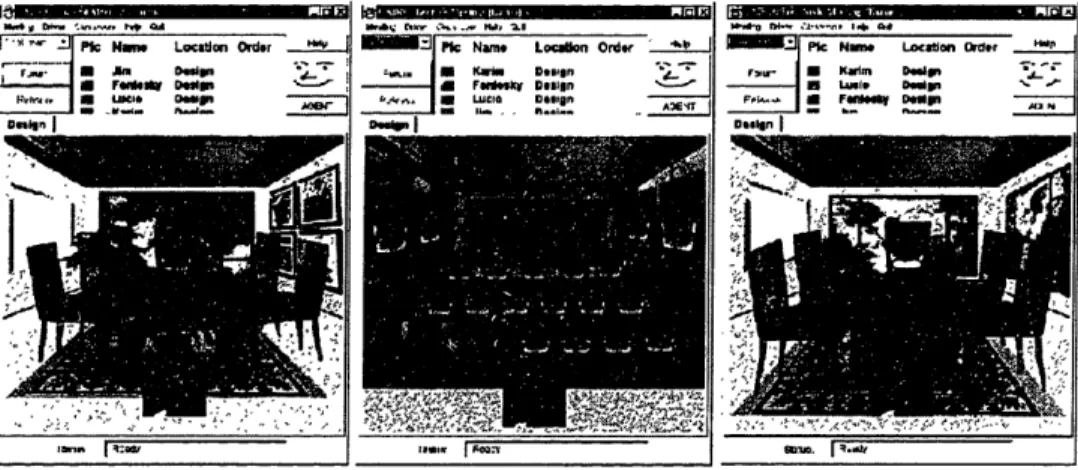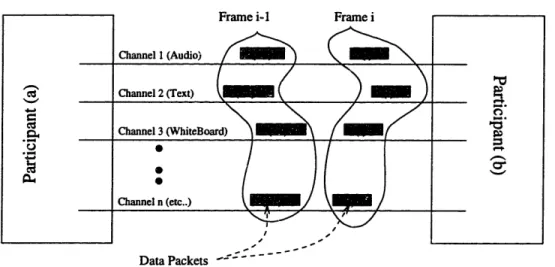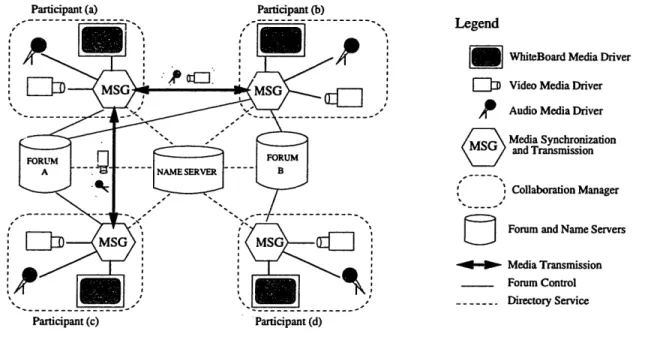Computer Supported Interaction in
Distributed Design Teams
by
KARIM MOHIE EL DIN HUSSEIN
B.S., Electrical Engineering and Computer Engineering, Carnegie Mellon University (1992) S.M., Civil and Environmental Engineering, Massachusetts Institute of Technology(1995)
Submitted to the Department of Civil and Environmental Engineering in partial fulfillment of the requirements for the degree of
DOCTOR OF SCIENCE IN INFORMATION TECHNOLOGY
at the
MASSACHUSETTS INSTITUTE OF TECHNOLOGY
May 1998
( Massachusetts Institute of Technology 1998. All rights reserved.
Author...
A
uthor
...
'.
-
...
Department of Civil and Environmental Engineering
pUay 22, 1998
Certified by...
----
Fei6sky Pefia-Mora
Assistant Professor of Civil and Environmental EngineeringThesis Supervisor
Accepted
by...
...
...
^
....
,1
,.
.,,,':jTs
:-
oseph M. Sussman
Chairman, Department Committee on Graduate Students
JUN 021998Computer Supported Interaction in
Distributed Design Teams
by
KARIM MOHIE EL DIN HUSSEIN
Submitted to the Department of Civil and Environmental Engineering on May 22, 1998, in partial fulfillment of the
requirements for the degree of
DOCTOR OF SCIENCE IN INFORMATION TECHNOLOGY
Abstract
Modern industrial design processes require collaboration among several specialists in the
re-alization of an artifact or product due to the large number of components and the hundreds
of person-years of knowledge encompassed in large engineering systems. Coordinating the activities of design groups and supporting the generative design process requires significant interaction among the individuals in a design team. In the past, such collaborative pro-cesses required many face to face meetings to produce high quality efficient designs. The availability of high speed computing and communication networks provides an infrastruc-ture alternative to physical meetings. Engineers can engage in design tasks while remaining
in their ideal work environments and can collaborate with others without concern for ge-ographical distance between them and their colleagues. This significantly reduces project
life cycle time and costs due to the enhanced communication between design team members
and the reduction of time and money spent in preparing presentations, going to meetings, and retrieving data.
This thesis presents the salient features of group interaction and a methodology for
supporting interaction in distributed design teams. The approach presented in the the-sis brings together research on meeting and negotiation processes with distributed
artifi-cial intelligence concepts to develop methodologies for intelligent facilitation of distributed computer-supported interaction. Models of meeting control structures, group dynamics, as well as conversation elements exchanged in the meeting setting have been developed from monitored design experiments. The characteristics of these design processes have
been successfully mapped to a scalable computer-supported multimedia interaction tool that includes a communication infrastructure and an interaction management system. Thesis Supervisor: Feniosky Pefia-Mora
Title: Assistant Professor of Civil and Environmental Engineering Doctoral Committee:
Prof. Jerome Connor, Prof. John R. Williams and Prof. Feniosky Pefia-Mora
Acknowledgments
I would like to thank Professors Feniosky Pefia-Mora, Jerome Connor and John Williams for their support and guidance throughout this study. I have particularly appreciated the latitude and guidance Prof. Pefia-Mora has provided me in pursuit of my research. I would also like to thank Professor Madnick, Dr. Amar Gupta and Dr. Michael Siegel who have expanded my research horizons and provided me with financial support during part of my stay at MIT.
I would then like to thank all at the Department of Civil Engineering, the Sloan School, and at MIT at large who have contributed in making of my stay in the Institute a most enlightening experience. I have met here, among faculty and students, a special breed of dedicated people who will always remain a source of inspiration.
Our research group at the Intelligent Engineering Systems Lab has always been a great resource. I would like to thank Wissam Ali Ahmed, Sanjeev Vadhavkar, Lucio Soibelman, James Kennedy, and Peter Cocozza who have provided technical support and have always been there as true friends. I would particularly like to thank Kareem Benjamin who has assisted with significant portions of the code for the CAIRO system over the past two years.
Special thanks to Dalia Ali, Mona Fawaz, Jean-Pierre Hathout, Ziad Kanaan, Hisham Kassab, Ahmed Mitwalli (who's been a great help since the beginning of this PhD trip and who has been with me until the day we both defended our theses), Amr Mohammed, Amine Tazi Riffi, Hala Tayyara and Maha Yahya who were always there to assist me in difficult times. They have lived through my pains and my joys and have always remained the truist of friends. A sincere thanks to the members of the MIT Arab Students Organization for making my stay at MIT pleasant and exciting. Finally, I would like to acknowledge the financial support of the National Sci-ence Foundation (NSF-CONACyT Grant No. IRI-9630021) and the MIT School of Engineering and the Department of Civil and Environmental Engineering under the James H. Ferry Jr. Fund for Innovation in Research Education. The research con-ducted was also supported by Kajima Corporation of Japan under the IESL-Kajima Program and Intel Corporation.
This thesis is dedicated to my parents, Mohie El Din Hussein and Mervat Badawi, and my sister, Noha Hussein, thank you for all the support throughout my life. You have taught me the value of education and have provided me with the means and
unconditional support I needed to achieve my goals. They forever will be my inspiration.
Contents
1 Introduction 1.1 Motivation ... 1.2 Objective ... 1.3 Methodology ... 1.4 Terminology ... 1.5 Thesis Overview ... 2 Literature Review 2.1 Recent Work 2.2 Interaction Systems ...2.3 Electronic Meeting Systems . . . 2.3.1 Xerox PARC Collab . . . 2.3.2 GroupSystems EMS . . . 2.4 Distributed Conferencing Systems
2.4.1 WVU MONET. 2.4.2 NCSA Collage ... 2.4.3 SRI CECED ... 2.4.4 AT&T RAPPORT .... 2.4.5 XTV ... 2.4.6 Microsoft Netmeeting... 5 17 17 19 20 22 23 25 25 ... . 28.. ... . .. 30 ... . .. 30 ... . .. 30 ... . .. 32 .... ... . . . .. 32 .... ... .. . .. 33 . ... .... ... .. . .. 34 ... . ... .. . .. 35 ... . .. 36 ... . .. 37
...
...
...
...
...
6 CONTENTS
2.4.7 Intel Proshare ... 38
2.5 Shared Social Spaces ... ... ... 39
2.5.1 TeamRooms ... 39
2.5.2 CoNus ... 40
2.6 Concluding Remarks ... 41
3 Groups and their Dynamics 43 3.1 Understanding Groups ... 44
3.1.1 Floor Transition ... 44
3.1.2 The Concept of Floor ... ... 45
3.1.3 Meeting Cycles ... .47
3.1.4 Group Life Cycles ... 47
3.2 Background on Interaction Dynamics ... 48
3.3
A
Sample
Task
Scenario
.... ....
... . ... 51
3.4 Experimental Methodology ... .54
3.5 Modelling Group Discourse ... 56
3.5.1 Focus of Attention ... 56 3.5.2 Degree of Engagement ... . . . ... 57 3.5.3 Participant Model ... 58 3.5.4 Floor Model ... 60 3.5.5 Model Verification .. .. . . ... 61 3.5.6 Modeling Results . . . .. . . 63 3.6 Conferencing ... ... 65 3.6.1 User Interface ... 66
4 Group Design Processes 71 4.1 Design Process Models ... 74
CONTENTS 7
4.1.2 Rapid Prototyping Model 4.1.3 Spiral Model ... 4.2 Negotiation ... 4.3 Agent Approach ... 4.3.1 Agent Architectures . . . 4.3.2 Facilitator Agent ... 4.3.3 Agent Environment .... 4.3.4 Agent Behavior ... 5 System Architecture
5.1 CAIRO System Services ... 5.1.1 5.1.2 Communication Con Control Infrastructu 5.1.3 Documentation . 5.2 Summary of Requirements 5.3 Architecture ...
5.3.1 Definitions...
5.3.2 CAIRO Client ... 5.3.3 Forum Server . 5.3.4 Name Server . 5.4 Operational Description 5.4.1 Forum Creation 5.4.2 Forum Startup .. 5.4.3 Participant Startup 5.4.4 Accessing Forums . 5.4.5 5.4.6 Retrieving Active/P Requesting to Speaklstraints
...
...
90
re ... 92... . 93
... . 97
... . 98
. . . ... . ... . . . ... . ... .~. 99... . 99
... . . . 110 ... . . . 118 ... . . . 118 ... . . . 119 ... . . . 120 ... . . . 121 ... . . . 121 ending List . . . .... 122.
... . 122
5.4.7 Communicating ... 74 76 76 80 80 81 84 85 87 88 CONTENTS 7...
...
...
...
...
...
...
...
123CONTENTS
5.5 Concluding Remarks.
6 Multi-User Interface
6.1 Interface Requirements ... 6.2 Metaphor Methodology ... 6.3 User Interface Description ...
6.3.1 Meeting Entry/Exit ... 6.3.2 Floor State.
6.3.3 Member State and Addressability . 6.3.4 Tool and Artifact Manipulation . . 6.3.5 Focus of Attention ... 6.3.6 Degree of Engagement ... 6.4 Implementation Issues. 6.5 Conclusions ... 7 Learning Environments 7.1 Introduction... 7.2 Educational Approach 7.2.1 Course Design ... 7.2.2 Learning Process .... 7.3 Interaction ... 7.3.1 Interaction Activities 7.3.2 Interaction Modes . 7.3.3 Interaction Infrastructure 7.4 The DISEL Class ...
7.4.1 The Setting ... 7.4.2 Development of Group an ... . . . 140 ... . . . 142 ... . . . 143 ... . . . 144 ... . . . 145 ... . . . 146
...
. 149
... . . . 151 ... . . . 152 d Team . . . .... 1547.4.3 Use of Distributed Tools ...
123 125 126 127 128 129 129 130 131 133 134 135 137 139 139 8
...
...
...
...
...
...
...
...
...
...
...
156CONTENTS
7.4.4 Student Surveys and Interviews ... 7.5 Guidelines ...
7.5.1 Technology Infrastructure.
7.5.2 Group Dynamics . . . .
7.5.3 Incentives and Evaluation ... 7.5.4 Feedback . ... 7.6 Conclusions ... 8 Conclusions 8.1 Thesis Summary. 8.2 Future Work . 8.2.1 Interface Development.
8.2.2 Group Process Control ... 8.2.3 Group Dynamics Analysis ... 8.2.4 Meeting Documentation.
8.2.5 Distributed Education. A Object Models
B Message Protocol
C Forum File Format
159 164 165 166 168 170 170 173 173 175 176 177 178 179 180 181 187 9 193
List of Figures
2-1 Interaction - a systems view. . . . 29
2-2 Overview of computer assisted communication . . . .. 42
3-1 Structure of Design and Development Conversations ... 45
3-2 Participation states. ... ... 59
3-3 Floor states ... 60
3-4 A complete view of the elements of the CAIRO research effort... 67
3-5 Metaphor for representing degree of engagement ... .... 69
3-6 Representing multiple floor control strategies - (a) Chaired (b) Lecture and (c) Brainstorming ... 70
4-1 Waterfall and Rapid Prototyping models of System Engineering and Development ... 75
4-2 Spiral Model of System Engineering and Development ... 77
4-3 The Collaboration / Conflict Circumplex (Adapted from Easterbrook
[25])
...
... .
78
4-4 The Agenda Tool. ... 83
4-5 (a) Chairperson Mode, (b) Lecture Mode, (c) Brainstorming Mode.. 84
5-1 The Collaboration Mechanisms in CAIRO' .. ... .. 90
5-2 Synchronization issues between two conference participants .... . 91
5-3 Control infrastructure model. ... 93
12 LIST OF FIGURES
5-4 The four dimensions of conversation in CAIRO4 ... 94
5-5 The DRIM object model ... ... 96
5-6 An example scenario of conversation structuring within CAIRO (in-tents are shown as rectangles, recommendations as rounded rectangles and justifications as elongated hexagons) ... 96
5-7 The CAIRO System: .' i overview. ... 99
5-8 A Sample Session of CAIRO ... 100
5-9 Message Server Overview: Media drivers for audio and whiteboard devices ... 102
5-10 Various methods for combining channels. Adapted from [Little and Ghafour, 1993] ... 103
5-11 Multi-channel frames . . . ... 108
5-12 Multimedia Frame Assembly from Input Media Channel Queues.... 109
5-13 Forum Manager User Interface ... 111
5-14 Hierarchical Forum Structure ... 114
5-15 The CAIRO Control Panel ... 119
6-1 Four dimension of User Interface requirements for Distributed Collab-oration ... 126
6-2 Door Controls ... 129
6-3 Meeting Entry / Exit Interface ... .. 130
6-4 Meeting with Side Conversations ... . 130
6-5 Speaking request - Feniosky is pending ... 131
6-6 Request Indicator - Chairman's (Karim's) Screen ... 132
6-7 Chairperson grants request ... 132
6-8 Feniosky is speaking ... 133
6-9 The CAIRO system user interface with several interaction tools . . . 134
6-10 Sketch of spring metaphor ... 135
LIST OF FIGURES
LIST OF FIGURES 13 6-11 Sketch of spring metaphor ...
6-12 Implementation of shadow metaphor
7-1 Multiple facets of the Distributed Collaborative I
...
.136
... .136
:earnii 7-2 A summary of the distributed course objectives Range of Interaction Modes ... Main Course Web page and Web structure ... DISEL Room schematic ... DISEL organizational structure ... Enthusiasm for Distributed Collaboration ... CAIRO Classroom Interface ... Distribution of activities in classroom settings ... Understanding of Material ... Understanding of Local/Remote Instructor ... Perceptions of Distributed Technological Infrastructure Perception of Mexican Counterparts ... Perception of group process ... Affects of distance on collaborative learning ... Results of Skill Surveys ... Modified DISEL classroom schematic ... Team contract outline ... Object Diagram: Overall Server Inter-connectivity . . . Object Diagram: Agenda Editor and Wizzard Classes . Object Diagram: Forum Server Classes ... Object Diagram: Components of a CAIRO participant Object Diagram: Media Driver classes ... Object Diagram: Queue Structure Hierarchy ... ig Consortium 141
...
.142
... .148
...
.150
...
.153
...
.153
...
.155
...
.158
...
.159
...
.160
...
.160
...
.161
...
.162
...
.162
...
.163
...
.164
...
.167
...
.169
...
.181
...
.182
...
.183
...
.184
...
.185
...
.186
7-3 7-4 7-5 7-6 7-7 7-8 7-9 7-10 7-11 7-12 7-13 7-14 7-15 7-16 7-17 7-18 A-1 A-2 A-3 A-4 A-5 A-6LIST OF FIGURESS
13 ..List of Tables
3.1 Floor state transition matrix . ...
3.2 Trends in floor transition for all three groups . ...
3.3 Use of focal and vocal interruptions in floor control in the three exper-imental groups ...
3.4 Use of focal and vocal interruptions in floor control segmented by mem-bers of Group A ...
5.1 A subset of temporal relations between a channel a and a channel . 7.1 Distribution of email-based activities ...
Forum Server Output Messages ... Forum Server Input Messages ... NameServer Output Messages ... NameServer Input Messages ...
Collaboration Manager Output Messages . Collaboration Manager Input Messages . .
... . . . 187 ... . . . 188 ... . . . 188 ... . . . 189 ... . . . 190 ... . . . 191 15 61 62 63 63 104 157 B.1 B.2 B.3 B.4 B.5 B.6
Chapter 1
Introduction
For PC's, the "killer apps" were word processing and spreadsheets. For the internet until now, e-mail and the web.
In the long-term future, the internet's killer app is for when you can't afford to be at the right place at the right time, which is now already
most places, most times. the internet's future killer app is telepresence,
going places by sliding your bits, as Prof. Negroponte would say, through
the internet instead of lugging your atoms through traffic, airports, hotels,
office parks, and conference halls...
I'm talking about massive substitutions of communication for
trans-portation.
- Bob Metcalfe, MIT Enterprise Forum Lecture, Oct. xx 1997
1.1 Motivation
"We are a meeting society" - a world made up of small groups that come together to share information, plan, solve problems, criticize or praise, make new decisions or find out what went wrong with old ones. All organizations are built up from groups of men and women. Regardless of their values or personal goals, individual members of these groups must coordinate activities and collaborate in order to achieve meaningful objectives and goals.
Coordination and collaboration are processes that are central to our livelihood. Self-sustenance is no longer a part of our society. Hence living stems from our ability
18 CHAPTER 1. INTRODUCTION
to rely on and cooperate with others in order to fulfill the needs we are unable to sustain. Language and voice emerge as necessary components of such cooperation. They are mechanisms for representation, production and transportation of informa-tion among individuals. Furthermore, society was developed as a force that governs these interactions among individuals an organizational process that enforces norms on the group to produce orderly interaction. This is a mechanism for the organization and control of the flow of information.
Traditionally, the mechanisms for interaction were natural - namely vocal chords and air. Electronic communication provides a new sphere for human interaction. Within this new sphere there are opportunities as well as constraints. In order to cope effectively with this new "ether" of interaction, the representation and produc-tion processes as well as the normative flow control and organizaproduc-tion mechanisms of natural interaction must be well understood. Since the transmission medium adds new dimensions to the interaction so should the representation, production, organization and control processes. As a society we are no longer constrained in communicating within the limits of geography since our interaction limits will only be determined by how far and how fast we can move our bits of information across the network. As Negroponte [61] has stated, we now live in a city of Bits rather than Atoms.
In the engineering domain, communication is an integral component of the design and problem-solving processes. Systems that are currently developed contain large numbers of components and encompass the knowledge of thousands of person-years. Clearly this is much more than one individual can retain in their limited mental stor-age capacity. Hence, the modern engineering process necessitates the engstor-agement of several individuals in the realization of an artifact or product. Engineering meeting processes particularly highlight several issues in communication: representation - dif-ferent standard terminologies and acronyms; transportation - in the form of symbolics, drawings, sketches, specifications and voice; organization and control - inter-linkages
1.2. OBJECTIVE 19
of system components and the need for diverse expertise in problem-solving, beyond the capacity of one individual.
Design teams and their interaction processes were chosen for this research since they provide a significant challenge to current communication technologies. Design processes require highly coordinated interaction to resolve design disputes and to align design goals within the team. Engineering design also typically involves ill-defined design problems that are composed of interrelated components designed by different individuals that must fit together to produce a working system. This adds another dimension of complexity to the coordination task, since access to the design artifact must be coordinated in order to avoid design failures. Finally, most engineering design requires multi-media interaction for product visualization and system architecture development.
The purpose of the research presented herein is to explore interaction paradigms for distributed interaction and to develop a system to support a coordinated dis-tributed design process. The system developed, CAIRO (Collaborative Agent Interaction control and synchROnization system) allows individuals to hold meet-ings over the internet and work together in a coordinated fashion on shared design problems. The system provides automated facilitation services and supports a variety of meeting structures and floor control policies.
1.2 Objective
The objective of this research is to explore meeting environments in physical space and interpret them into a virtual environment as well as to exploit the unique char-acteristics of the new, communication medium. This is accomplished through the deconstruction of group interaction into its core elements and the translation of these elements into computational representations. In addition, facilitation processes have been modeled in order to allow intelligent agent manipulation of the meeting process.
20 CHAPTER 1. INTRODUCTION Traditional meetings impose physical and temporal constraints upon conferring individuals. These constraints are eliminated through a system that provides virtual meeting environments through distributed computer networks. The CAIRO project focuses on exploring mechanisms for automated facilitation of meetings to reduce overhead costs incurred by the coordination and facilitation of standard meetings.
In order to provide support for the relaxation of the same place constraint, a dis-tributed conference architecture has been developed that provides synchronized mul-timedia communications among multiple participants over the internet. Mitigation of the temporal constraint is somewhat more complicated. In physical meetings, late participants disturb the progress of the conferring group by requiring that they reca-pitulate. In this virtual meeting setting, however, late participants can immediately catch up with meeting proceedings through an automated documentation system.
The general dynamics of group interaction can be analyzed on two levels, the se-mantic and the syntactic. At the sese-mantic level, these dynamics involve the broader context of the meeting in terms of its goals and the process by which those goals are achieved. This includes providing flexible and dynamic floor control algorithms, automated facilitation services, group structuring and agenda structuring tools for distributed interaction. At the syntactic level, the group dynamics involve the tran-sition of floor from one individual to another. Supporting these dynamics through computer representations involves providing mechanisms that enable requesting the floor, addressing individuals in the distributed interaction, and managing the transi-tion from one individual to another.
1.3 Methodology
A multi-disciplinary approach was taken for the analysis, design and development of the CAIRO system to support interaction in distributed design teams. Preliminary analysis of the problem domain was conducted through an analysis of management
1.3. METHODOLOGY
and sociology literatures as well as computer science literature. In the management literature, three subject areas that are relevant to this research were examined: (a) discourse analysis and group dynamics; (b) high performance design teams and group design processes; and (c) negotiation and facilitation. From the technology perspec-tive, the domains covered were distributed network systems, real time systems, agent-based systems and computer conferencing systems that are precursors to the CAIRO system.
The next phase of the research involved the modeling of group interaction, design processes, and facilitation. These models are necessary to allow for computer un-derstanding of the human design process. After a review of the literature, gaps were determined in the modeling of group interaction. Several controlled experiments were conducted on groups in physical meeting settings. The data from these experiments was analyzed and models were developed for group interaction. These models in addition to facilitation models served as a basis for the design of the CAIRO system. Once the models were derived, elements of these group interaction models were analyzed to determine the dependence of these social protocols on physical presence. Concepts that were not apparent in distributed interaction were re-mapped into the distributed domain through user input and output structures or through intelligent moderating systems. Mapping of these concepts involved a close examination of metaphors employed in the user interface since they are critical in the effectiveness of this human-centered communicative tool.
A set of tools was then developed that provided computer support for design inter-action across distance. The tool was designed to provide for scalability in the number of users as well as in the multiple media used in the distributed interaction. Several prototypes were developed and tested among limited users and certain elements of the interface have been redesigned.
Finally, a "real world" test scenario was created through a distributed software
22CHPE1.ITOUTO
engineering course taught simultaneously at MIT and at CICESE in Mexico. The course served as a test bed for several group interaction tools. Feedback from students as well as tool use patterns have provided this research effort with significant support for the CAIRO tool developed and outlined several important considerations for future interaction systems.
1.4 Terminology
The definition of terms in the computer meeting field are generally quite vague and contradictory in the literature. The following list provides a set of basic terminology that will be used consistently throughout this thesis.
Agenda: a set of guidelines for the topics of discussion in a particular meeting
set-ting.
Asynchronous: asynchronous interaction is communication that is stored in some
form before transmission to the receiver of the information.
Collaboration: to work jointly with others especially in an intellectual endeavor.
Conferencing: conferencing is the act of structured and formal group interaction,
throughout this thesis it will refer exclusively to distributed group interchange.
Facilitation: providing process interventions in group discussion to enhance the
ef-ficiency and effectiveness of the interaction.
Floor: the right of one member of a group to communicate to other members within a group discussion or meeting.
Interaction: communication that engenders reciprocal communication or action.
Knowledge: the conceptual model of the environment and other information that a
person is exposed to and assimilates.
1.5. THESIS OVERVIEW 23 Learning: the process by which knowledge is built, transferred and shared.
Meeting: individuals coming together for a common purpose.
Negotiation: the process of resolving conflicts or disputes among individuals. Synchronous: happening, existing, or arising at the same time. Synchronous
in-teraction refers to communications that are immediate and whose expected response is immediate. These include face to face meetings, telephone calls and video conference interactions.
Telepresence: the ability to provide a semblance of co-location of distributed
indi-viduals through the use of computer and communication technologies.
1.5 Thesis Overview
The following chapter presents an overview of current academic and commercial telep-resence systems. Each system will be reviewed for their effectiveness in supporting distributed design processes based on criteria developed within the chapter. Chapter 3 discusses patterns in interaction and floor transition in groups based on experi-ments conducted during this research. The chapter concludes with a discussion of recommendations for the design of distributed group interaction systems. The design process is then discussed in detail in Chapter 4. This includes a discussion of generic engineering design models in addition to negotiation and facilitation support pro-cesses. An agent architecture is then proposed to provide the facilitating role within a distributed design support system. Based on the requirements of distributed com-munication and the necessary support for complex forms of interaction described in Chapters 3 & 4 a robust and scalable network infrastructure and system architecture are presented in Chapter 5. This is followed by a discussion of user interface consider-ations and a description of the final interface implementation in Chapter 6. Chapter
24 CHAPTER 1. INTRODUCTION
7 presents a distributed learning classroom experience which served as a test-bed for the CAIRO system. The chapter discusses the learning philosophy employed in the course and the variety of technologies used to support the distributed interaction within the classroom. The chapter concludes with an analysis of the effectiveness of various interaction technologies (including CAIRO) in supporting a distributed learn-ing environment. A summary of the findlearn-ings in this thesis as well as suggestions for future work are presented in the final chapter.
Chapter 2
Literature Review
2.1 Recent Work in Computer Mediated
Com-munication
The emergence of high speed communication networks and improved visualization techniques has laid the foundation for computer based collaboration. Various collab-oration tools have been developed by academic institutions, office system manufactur-ers and communication companies. In this chapter, the major conferencing systems that have been developed are reviewed.
The literature is rich with research in the area of computer mediated communi-cation. The work spans multiple disciplines and hence there are three diverse focus areas in this research field': Electronic Meeting Systems(EMS); Video Conferenc-ing; and Shared social spaces. Each of these groups represents a different approach to computer mediated communication. EMS research focuses on the meeting pro-cess and decision support tools for the meeting propro-cess. Video conferencing research is concerned with transmitting multi-media data between participants (esp. audio
'This classification is based on the commonalities within the different subgroups. Researchers in all three different fields tend to use multiple vocabularies that can confuse the functionality of the systems
26 CHAPTER 2. LITERATURE REVIEW and video data). The shared social spaces perspective is concerned with enabling interaction and experience across distance and providing awareness and persistence within a virtual world. The following paragraphs will discuss the salient features of representative systems in each of these areas.
Electronic meeting systems encompasses a large body of research dedicated to the support of participants in traditional meeting settings. These systems arose from defense needs for efficient command and control centers. The GroupSystems EMS[63] and the Xerox Parc Collab project[91] are among the first such systems developed. Both systems have tools that structure brainstorming and problem solving processes and enforce interaction controls on the participants within the shared media. How-ever, the control of floor in discussion is governed by regular meeting norms since all participants are co-located. Olson et aL[65] found that some of these additional pro-cess structuring constraints on the collaboration are not nepro-cessary and may decrease satisfaction within the workgroup. Further analysis of the use of these systems and
their effect on group work are well documented[64, 39, 26].
Initial research on video conferencing focused on the technical aspects of trans-mitting video and audio data among individuals. Much of the initial work was con-strained to two-person interactions and a large portion of the work utilized a telephony paradigm for the interaction. Further developments have occurred rapidly in this field and most modern systems such as Microsoft NetMeeting[55], Intel Proshare[43], PictureTel[75], and SGI Inperson[88] provide multi-person interaction and have ex-tended audio and video services to include shared whiteboards, editors and browsers. However, these conferencing systems lack any appropriate concurrency control mech-anisms and are cumbersome to use for group work.
The final area of research in tele-presence is devoted to the study of virtual com-munities and interaction in a virtual environment. Several tools have been developed
2.1. RECENT WORK 27~~~~~~~~ to provide awareness, persistence, and interaction in cyberspace. The two leading
re-search efforts in this field are TeamRooms[80] and Worlds[31]. The primary concern of these research efforts is in the representation of physical concepts of space and place in the virtual world. The environments developed provide richer interaction contexts, but are currently constrained by network bandwidth and display technology.
The research described in this thesis builds on earlier work in all these fields espe-cially earlier work on electronic support for physical meetings. However, our aim is to extend support mechanisms to distributed meetings using commercial video confer-encing technology. This necessitates the introduction flexible control and interaction support tools to compliment the decision support and conferencing infrastructures. The group interaction research described herein in addition to the recommendations presented are an initial step in providing such group support.
Telepresence is a term used to describe a variety of systems for interaction in dis-tributed environments. This section will review the majority of seminal works in this field. This field includes a wide variety of devices and software systems that enable communication among groups of two or more individuals, including telephone sys-tems. This review will be restricted to the class of systems that use general purpose computers connected via a network using any of a variety of communication proto-cols including TCP/IP (the Internet Protoproto-cols), ISDN (Integrated Services Digital Network) and ATM (Asynchronous Transfer Mode).
Descriptions of each system include:
* a brief overview of the architecture of the system,
* a description of the various media supported by the system (eg. X-window, audio, and video).
* Support for temporal dependence among various media channels, i.e.
28 CHAPTER 2. LITERATURE REVIEW dia synchronization.
* support for higher level protocols to control meeting structure and floor control, i.e. collaboration and floor control.
· support for meeting logging and efficient retrieval mechanisms, i.e. process history support.
* effective transmission of information, i.e. addressability, reasonable delay times and minimal information loss (reliability).
2.2 Interaction Systems
The telepresence systems were analyzed based on the following critical system com-ponents:
Communication Protocol : A set of rules for information transmission across a
network.
Interaction Protocol : A set of rules and algorithms that govern the accessibility
of other participants in an interaction. These include definitions of proximity (proximity in a distributed sense has different implications than in the physical environment), addressability (controls over the ability to interact with others in the interaction environment) and presence (definitions of visibility of individuals to others).
Interaction Environment defines the interface between human and machine
mod-els of the interaction. These are typically exemplified by metaphors that repre-sent protocol distinctions. For example a room metaphor is commonly used to denote presence of individuals and proximity.
2.2. INTERACTION SYSTEMS 29
Interaction Modality defines the variety of information structures and media
avail-able to the interaction. These may include audio transmission, video transmis-sion, image transmistransmis-sion, text transmission and structured data (in the form of databases, schedules, CAD drawings, formatted text, etc...)
These components are combined to form an interaction system as shown in Fig-ure 2-1. The interaction environment defines the space for the individual's interface to the machine and other networked individuals, while the interaction modality defines the input and output devices by which information is displayed within each indi-vidual's interaction environment. Communication protocols enable the transmission of information from one machine to another through the network. Finally, interac-tion protocols enforce order on the communicainterac-tion over the network collaborainterac-tion by controlling the ability to address particular individuals..
Figure 2-1: Interaction - a systems view
30 CHAPTER 2. LITERATURE REVIEW
2.3 Electronic Meeting Systems
2.3.1 Xerox PARC Collab
The Xerox PARC Collab Project's [91] main emphasis is on collaboration control mechanisms for a shared board. Their work provides valuable insights into meeting cycles and social interaction during a group meeting. However, Collab is lacking in multimedia communication and assumes all participants are physically co-located.
Architecture: The Xerox Collab project is comprised of several tailor made shared
applications for specific meeting functions (Board Noter, Cognoter etc...). There is no meeting or name server incorporated within the system
Media Support: The Collab system is a highly specialized system and therefore
has only one shared application (i.e. a Whiteboard).
Multimedia Synchronization: None, since only one media is present.
Collaboration and Floor Control: Complex floor control mechanisms describe
in detail in Section 3.1.3.
Process History: Personal notes and Snapshots of screens are allowed. Activity
on the shared board is also continuously logged.
Reliability: Closed network (LAN) system with very high reliability.
2.3.2
GroupSystems EMS
The University of Arizona / IBM GroupSystems EMS (Electronic Meeting System) joint effort [63] extends the work undertaken in the Xerox Collab project. They
2.3. ELECTRONIC MEETING SYSTEMS 31 provide mechanisms for retaining organizational memory, process support and struc-turing, task planning and structuring as well as control support for three basic meet-ing types (chauffeured, supported and interactive). As in Collab, GroupSystems EMS does not support multimedia communication and assumes a co-located meet-ing. Many of these EMS systems have been set up in convention centers to allow speedy issue resolution among top executives.
Architecture: GroupSystems EMS consists of a network of computers in a
special-ized meeting room with a large projection screen. Specialspecial-ized software runs on each machine to provide support for process design and scheduling.
Media Support: Process support and structuring applications are provided (eg.
Electronic Brainstorming, Electronic Discussion, Idea Organizer, Issue Analyzer, Vote Selection, Policy Formation).
Multimedia Synchronization: No synchronization is required since meetings are
carried out face to face.
Collaboration and Floor Control: Three meeting types are supported:
1. Chauffeured - Single person enters group information.
2. Supported - All group members can enter comments, however, there is a central control on group memory access.
3. Interactive - All group comments and actions are logged in group memory.
Process History: Very detailed process support and structuring and extensive
group memory maintenance (queuing and filtering).
Reliability: Closed network (LAN) system with very high reliability.
32 CHAPTER 2. LITERATURE REVIEW~~~~
2.4 Distributed Conferencing Systems
2.4.1 WVVU MONET
MONET (Meeting On the NETwork) [90], developed by CERC at West Virginia Uni-versity, is among the first and most complex research efforts in conferencing systems. This project was supported by the DARPA DICE initiative.
Architecture: The MONET system is comprised of application sharing servers,
conference servers, multimedia servers and a directory server. The application sharing server (COMIX [7]) intercepts XClient calls from any X application and broadcasts them to the members of a conference. The conference servers handle membership, invitation processing and archiving for an active conference. Multimedia servers' key function is inter-media synchronization, however, this portion of the MONET system has not been fully implemented. Finally, a directory server maintains lists of registered participants as well as characteristics associated with those participants. The MONET system has a simplistic user interface that is quite cumbersome to use.
Media Support: MONET provides support for audio, video and shared X
applica-tions. Audio and video capabilities are limited, however, and are comprised r.inly of annotations to text rather than as an effective real time communication mechanism. The shared X system allows all participants access to any X application.
Multimedia Synchronization: Although multimedia synchronization is mentioned
as a goal for MONET, no indication of synchronization was provided. Much of the effort has been focused on providing operating system and hardware support for syn-chronization.
Collaboration and Floor Control: MONET provides three basic floor control
mechanisms: chairman control, time-limited FIFO, and a combination of the two.
2.4. DISTRIBUTED CONFERENCING SYSTEMS
There is no support for extension or design of more complex mechanisms.
Process History: MONET provides no conference logging facility.
Reliability: No information available.
2.4.2 NCSA Collage
NCSA's Collage [60] conferencing tool has a characteristically clean interface similar to NCSA Mosaic. NCSA Collage was designed with a focus on visualization appli-cations and hence has complex image visualization and manipulation mechanisms incorporated within it.
Architecture: NCSA Collage is based on a strict client-server model. All
partici-pants initiate NCSA Collage sessions and NCSA Collage Servers are created as each conference is initiated. All future communication by participants in a conference are passed through the newly created NCSA Collage server. NCSA Collage lacks any form of directory service. NCSA Collage is also available on Macintosh and Windows platforms which greatly enhances its usefulness.
Media Support: Whiteboard, Text, Animation, and Image visualization tools are
the core media supported by the NCSA Collage system. NCSA Collage also incor-porates an effective screen capture mechanism. No support for audio and video is included in the current system.
Multimedia Synchronization: Due to the lack of audio or video media in NCSA
Collage, no synchronization mechanism is incorporated within the system. All media drivers have no temporal dependence.
CHAPTER 2. LITERATURE REVIEW
Collaboration and Floor Control: No floor control protocol is provided with
the NCSA Collage system. All clients have access to the shared application and all interactions are broadcast to members of a conference.
Process History: No history of a conference session is maintained by the NCSA
Collage Server. However, local snapshots of conference proceedings can be maintained by each client.
Reliability: No directory service provided.
2,4.3
SRI CECED
The Collaborative Environment for Concurrent Engineering Design (CECED), de-veloped by SRI International, provides mechanisms for informal communication and history capture of informal stage in the specification and design process. The work undertaken has detailed the requirements for effective conferencing systems. SRI's ap-proach has been to ensure that the conference system is non-intrusive and as natural as a standard meeting conversation.
Architecture: CECED builds on the MOSAIC platform (Multimedia Open System
for Augmented Interactive Collaboration [18],
[32]). As in the MONET and XTV systems, CECED distributes existing unmod-ified X applications. This is performed by specialized Collaboration Management Agents (CMA). A Shared Tool Event CMA provides broadcast capability to existing XClient applications. A connection CMA handles all underlying network protocol translations. A Session Manager acts as a user interface to the conference tool. An Information Store CMA provides archiving and data access control for the collabora-tive conference. CECED also incorporates Collaboration Aware Tools (CAT). These are specifically developed tools for the CECED system. The current prototype has
2.4. DISTRIBUTED CONFERENCING SYSTEMS
an audio CAT to allow for audio communications in the collaborative environment.
Media Support: CECED supports any X-based application as well as limited
au-dio capability through the auau-dio CAT.
Multimedia Synchronization: Synchronization can be implemented as a CMA
among various X-applications. However, the CECED prototype does not include any inter-media synchronization
Collaboration and Floor Control: CECED provides synchronous multi-user
ac-cess. The access control protocol is similar to the Ethernet concept. It involves a listening process that waits till the line is free and then allows the participant to speak. This process known as COMET [33], is a distributed activity sensing floor control algorithm that guarantees a single stream of input to unmodified single-user applications.
Process History: CECED provides only a complete logging of conference
proceed-ings. Furthermore, CECED provides logging of semantic changes in the conference as well as raw data.
Reliability: Completely distributed. No directory service is provided.
2.4.4
AT&T RAPPORT
The AT&T RAPPORT [4] system focuses on the network communication issues of conferencing and on effective user interface design for conferencing tools. It provides synchronized video, audio and data communication, however, RAPPORT uses het-erogeneous networks for each mode of communication (PBX for audio, coax cable for video, LAN for data). RAPPORT also lacks effective support for conference control.
36 CHAPTER 2. LITERATURE REVIEW
Architecture: Proprietary.
Media Support: Provides voice, video and shared X applications.
Multimedia Synchronization: Synchronization is not necessary since the system
has virtually no communication latency. Currently, Rapport runs on three separate networks: a LAN for data transmission, a specialized coax video network for video, and an ISDN system for audio communication.
Collaboration and Floor Control: Chalk passing is the only control mechanism
suggested.
Process History: No capture of process history is captured aside from screen
snap-shots and note-taking applications.
Reliability: Highly reliable communication with no data loss due to the nature of
the network. However, the system is prohibitively expensive and not easily scalable.
2.4.5 XTV
The XTV [1](X Teleconferencing and Viewing) effort focuses primarily on providing reliable transfer of data among shared X systems. XTV incorporates a very simple floor control mechanism and does not provide support for non-X media communica-tion.
Architecture: The XTV system is comprised of three key components: information
daemons (ID), conference announcers (CA) and user interfaces (UI). ID's maintain communication among the UI's and the CA's. ID's are equivalent to meeting rooms in a physical conference. UI's are each individual participant in a conference. A UI is an
2.4. DISTRIBUTED CONFERENCING SYSTEMS
X-application used by a conference member that can be shared among all participants. CA's maintain conference membership lists and process conference invitations.
Media Support: XTV only supports X-based applications.
Multimedia Synchronization: No synchronization among X applications is
pro-vided by the XTV system.
Collaboration and Floor Control: Chalk passing protocol with a chairman
over-ride capability.
Process History: No explicit process history capture mechanism is provided by
XTV.
Reliability: Provides redundant servers to insure fault tolerance and employs
so-phisticated protocols to insure reliable information transfer.
2.4.6 Microsoft Netmeeting
Microsoft Netmeeting [55] is the most prevalent video conferencing system currently in use. It provides the most effective support of video and audio on the internet. It provides no synchronization support among the multiple media channels. Netmeeting also does not support video and audio interaction among more than two people across the internet. However, windows applications and chats may be shared among more than two individualts. Netmeeting lacks any effective support for conference control. Any member of a meeting in Netmeeting can access a shared application by taking the speaker control from any other member. This is a very confusing concurrency control mechanism that can lead to a continuous tug of war for control of the floor.
Architecture: Based on Intel Proshare technology[43].
38 CHAPTER 2. LITERATURE REVIEW
Media Support: Provides voice, video and shared Windows applications.
Multimedia Synchronization: Synchronization is not supported in current
ver-sions of Netmeeting. However, inter-media latency is limited and the media channels are presented almost synchronously.
Collaboration and Floor Control: Chalk "grabbing" is the only control
mecha-nism provided.
Process History: No capture of process history is captured aside from the regular
"save" commands of the shared applications.
Reliability: Semi-reliable communication with significant data loss across congested
networks. However, a network monitor is provided to determine congestion on the network.
2.4.7 Intel Proshare
The Intel product is very similar to the system provided by Microsoft. In fact they share the same media transmission system. However, Proshare[43] provides some additional functionality yet requires Intel video hardware to work efficiently. Proshare provides communication over ISDN lines with multiple conferencing individuals. It is, however, limited to two conferring individuals in regular internet mode. Although, the Intel system provides an elegent interface using a room metaphor (switches to office and lecture hall depending on interaction mode), there is no individual addressibility in group ISDN mode.
Architecture: Based on Intel Proshare technology (Internet and ISDN support
with Intel hardware)[43].
2.5. SHARED SOCIAL SPACES 39
Media Support: Provides voice, video and shared Windows applications.
Multimedia Synchronization: Synchronization is not supported in Proshare.
However, inter-media latency is limited (particularly in ISDN mode) and the me-dia channels are presented almost synchronously.
Collaboration and Floor Control: Chalk passing and "grabbing" are the control mechanisms provided. Audio and video conferencing is uncontrolled, except in lecture mode where a single video and audio source is multicast.
Process History: No capture of process history is captured aside from the regular
"save" commands of the shared applications and video snapshot capabilities.
Reliability: Semi-reliable to reliable communication with significant data loss across
congested networks. In ISDN mode, communication is highly reliable and of very good quality due to Intel's hardware video and audio compression. Proshare also provides a network monitor to determine congestion on the network.
2.5
Shared Social Spaces
2.5.1 TeamRooms
The TeamRooms[80] research effort focuses primarily on the representation of in-teraction spaces. The room metaphor for a multi-user interface is used extensively within this system. It provides a highly consistent interface to interaction among group member using both asynchronous and synchronous media. Persistent objects may be placed within a room for later retrieval and participants in a single room may communicate in real time.
40
CHAPTER 2. LITERATURE REVIEW
Architecture: Based on a MOO (Multi-User Dialogues extended with Object
Ori-ented programming).
Media Support: Provides voice, and shared applications.
Multimedia Synchronization: Synchronization is not supported.
Collaboration and Floor Control: Object-based locking with permissions set by
object owner. Complex control schemes may be incorporated but are cumbersome to program. Voice interaction based on co-location in a team room.
Process History: Process history is captured through persistent objects
main-tained in a team room.
Reliability: Reliable communication using MOO infrastructure.
2.5.2 CoNus
The CoNus[9] system is an extension of the TeamRooms concept (see previous section) without the use of a MOO infrastructure. The CoNus system provides video and audio conferencing and extends the room metaphor with floors and buildings (providing a room hierarchy). The system also supports persistent objects.
Architecture: The system is based on a combination of real time conferencing
systems and a MOO-like system.
Media Support: Provides voice,video and shared applications.
Multimedia Synchronization: Synchronization is not supported.
CAPTER 2. LITERATURE REVIEWV 40
2.6. CONCLUDING REMARKS 41
Collaboration and Floor Control: No explicit floor control is provided by this
system.
Process History: Process history is captured through persistent objects
main-tained in a room.
Reliability: Semi-reliable communication infrastructure that is highly reliant on
network bandwidth. Tests have been primarily performed by the authors on high speed ATM (Asynchronous Transfer Mode) networks.
2.6
Concluding Remarks
The above systems provide an overview of the wide array of conferencing software available on the market. Three classes of conferencing software were discussed in the preceding sections: electronic meeting systems, distributed conferencing systems and shared social spaces. The electronic meeting systems (GroupSystems EMS and Xerox Parc Collab) are in general more focused on meeting organization and coordi-nation, since the architecture of the system depends on the physical co-location of the group members. The distributed conferencing systems, on the other hand, ignore the coordination problem and concentrate primarily on co-location facilitators (i.e. multi-media information transmission). Finally, shared social spaces are designed primarily to support group gaming environments. They are occasionally used for distributed work, however, they have limited support for structured interaction although they have highly developed telepresence and addressing mechanisms. The approach taken in this thesis is to achieve an appropriate balance of distributed meeting co-location and coordination technologies.
Some of the current computer mediated communication systems (both academic and commercial) are classified in Figure 2-2. The figure delineates the multimedia
42
CHAPTER 2. LITERATURE REVIEW
pabilities of the systems on the y-axis. The x-axis describes the extent to which these systems support multiple participants in an interaction. Finally, the z-axis expresses the degree to which the systems allow effective control of the floor (concurrency con-trol) in collaborative interaction. The core focus of this thesis is on the z-axis although the existence of multimedia and multi-user support are necessary prerequisites for the work described herein.
Low MultiUser Support High
References worlds: Fitzparick et al. 1995 AT&T Rapport: Ahuja and Ensor 1992
ClearBoard: Ishii et al. 1994 SRI CECED: Craighill et al. 1993 Xerox Collab: Stefik et al. 1987 IVS Raendvus: Tturett 1994 MONET: Srinivas et al. 1992 Group EMS: Nunamaker et al. 1991 MS NetMeeting: Microsoft Corp. 1997 SGI InPason: Silicon Graphics 1997 Lotus Notes: Marshak 1990
Netscape Coolulk: Netscape Corp. 1997 PicturTel: PicturmTel Corp. 1997 TeamnRooms: Roseman and Greenberg 1996 GroupLab: Roseman and Greenberg 1996 Intel Proshare: Intel Corp. 1996
Chapter 3
Groups and their Dynamics
We respond to gestures with an extreme alertness and, one might al-most say, in accordance with an elaborate and secret code that is written nowhere, known to none, and understood by all.
- (Edward Sapir, 1928)
Understanding design team interaction requires an understanding of the internal dynamics of groups. The following section provides the relevant background infor-mation on group dynamics and interaction. Section 3.3 provides a scenario from the AEC industry to illustrate the concepts discussed in this paper. This is followed by Section 3.4 that describes the methodology utilized to gather data to use as a ba-sis for deriving the models of floor control which are described in Section 3.5. This is followed by a set of recommendations for any conferencing system that supports the group dynamics present in civil engineering interactions must satisfy. A proto-type conferencing system and a floor control infrastructure are also presented in this section. Concluding remarks and future work are presented in the final section.
43
CHAPTER 3. GROUPS AND THEIR DYNAMICS
3.1 Understanding Groups
Group interaction patterns are an early indicator of a disfunctional group process. If users are aggravated and are starting sub-conversations then there is a clear deficiency in the control process. Patterns of interpersonal communication have often been used by social scientists to determine the effectiveness of team processes. We intend to have the computer agents analyze these communication patterns and hence determine the effectiveness of the team process.
3.1.1 Floor Transition
The key difficulties in providing automated facilitation of design meetings correspond to discourse transition decisions and group transition processes. Discourse transitions exist at two distinct levels. The first level is in turn taking transitions, and the second level consists of meeting process transitions. Due to the primitive state of natural language understanding these transitions must be realized from syntactic clues rather than from the semantic content of the interaction. Early analysis of data derived from various meeting forms as well as studies by Schiffrin [85] indicate that syntactic clues are a promising indicator of transition points.
Discourse analysis allows the extraction and interpretation of inflections in speech and a categorization of typical techniques employed by people in conversation to indicate relinquishing of floor control [85, 94]. The CAIRO research effort will build upon these studies and attempt to distinguish discourse markers in multiple media rather than just verbal communication.
Group interaction occurs within the context of a meeting process and a group life cycle. A description of meeting process is presented in Section 3.1.3. Group life cycles and their effect on group functioning is further discussed in Section 3.1.4.
3.1. UNDERSTANDING GROUPS 45 PRo ofoup hQdPu Pa Dme Jems Sychrosnu Ayncbraowu
Figure 3-1: Structure of Design and Development Conversations
3.1.2 The Concept of Floor
This section presents a brief background on group communication with particular emphasis on the transition of the speaking state (the floor) from one participant to the other. Two key characteristics of efficient meeting (i.e., increased information flow and equal participation of individuals) greatly depend on efficient floor transfer policy. In fact, floor control policies are the principal concern of meeting facilitation
strategies. [21]
The concept of floor represents the speaker state within a group discourse. Floorl
com-monly refers to the right of a member to communicate to a group (e.g., the project manager addressing contractors), alternatively, the term has also been used to refer to the topic of focus in a group discourse [Edelsky,1993]. For the purposes of this research, floor will refer to the right of a member to communicate to the group.
Several techniques have been proposed to enhance the floor transition process in
lfloor(n.) (1) the part of a legislative chamber, auditorium etc. where the members sit and from which they speak; (2) the right of one member to speak from such a place in preference to other members. - Random House College Dictionary, 1995 edition.
CHAPTER 3. GROUPS AND THEIR DYNAMICS task-oriented group work, including formal methodologies for facilitation [29, 92] and a fruitful business in group process consulting [84, 83]. The control of floor has been shown to affect power dynamics within a group and repressive floor control policies can stifle innovation and creativity in a group (see Patton et al. [67] and Walton and Hackman [96]). Furthermore, ineffective floor policies may lead to frustration, anxiety and conflict within the group.[58]
In order to enhance the floor transition process, there are two main issues in group dynamics that this paper addresses. The first is to investigate the possibility of extending current work on dyadic2 turn-taking theories[23, 35, 95] and applying them to group floor control in a task-oriented setting, such as a change negotiation meeting in a civil engineering project, using discourse analysis. Most research on turn-taking does not take into consideration the situation when more than two persons are conversing. This paper argues that the two phenomena are different and use diverse modality and various discourse elements. In addition, a dyadic model will not work in large-scale engineering projects where a negotiation or design meeting rarely involves only two parties. However, the current work on dyadic turn-taking offers a good ground to pursue further analysis for group activities. The second problem addressed by this research is the derivation of a model for floor transition based on observed data and on the discourse analysis influenced by turn-taking. The model is based on a consistent description of the various states that a group will experience while exercising floor control. The validity of the derived model will be shown by mapping some of the concepts back to the actual data. This model will then become the basis for a set of requirements for computer conferencing systems to be used on problem solving distributed meetings in civil engineering projects.
2two-person interactions
